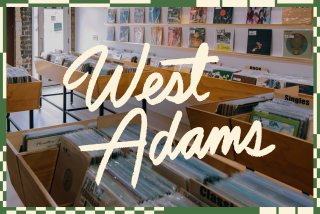Oxnard . . . It’s Not in Kansas Anymore
- Share via
OXNARD — If it weren’t for some stately palms and a scent of ocean salt, there are settings here that remind one of a small, turn-of-the-century Midwest city: modestly detailed Victorian houses and clapboard bungalows with inviting front porches on broad, tree-shaded lawns; a brick-clad, Gothic Revival-styled church reaching for the sky; a proud, neoclassical terra cotta-encrusted bank.
These and some scattered forlorn, dated farmhouses and fruit and vegetable stands are the remnants of this city’s rich history as an agricultural center, located at the western end of the Santa Clara Valley midway between Los Angeles and Santa Barbara--and, architecturally, somewhere on the plains of Kansas, until recently.
Focus on Agriculture
As evidenced by the broad, fertile fields edging the city, agriculture is still very much a prime industry in the area. But Oxnard is changing in spirit and style. There are office complexes, industrial parks, mini-malls that appear to have been trucked north on the Ventura Freeway from Los Angeles, and burgeoning seaside residential and recreational developments that might have floated up the coast from Marina del Rey.
Most prominent among the new commercial structures is the 21-story reflective, tinted-green-glass-clad Union Bank Tower dominating the Financial Plaza complex southeast of the intersection of U.S. 101 and California 1. It was designed in a functional, Modernist mode by architect Ebbe Videriksen and graced at ground level by a sleek stainless fountain in a black granite pool, sculpted by artist Rafe Affleck.
Modestly attempting to blend the old and new, Oxnard is a recently completed transportation center combining an Amtrak station and a bus terminal just east of Oxnard Boulevard (California 1) at 4th Street downtown. The design by the architectural firm of Leach & Kehoe features a welcoming entry--marked by a brick clock tower and an extended porte-cochere--and a skylighted two-story waiting room adds to the brightness of the interior.
Environs Spruced Up
The parking lot and streets fronting the center also have been spruced up, as has an old market to the south, Plaza Las Glorias. It is impressive what some sensitive landscaping, street trees, new brick paving and crosswalks, some tasteful touches of paint and general maintenance can do to breathe new life into an area.
Across Oxnard Boulevard at the northeast corner of A and 5th streets stands the landmark Bank of A. Levy, an imposing neoclassical structure designed by the Los Angeles architectural firm Morgan, Wells & Clement and built in 1927. It is a marvelously indulgent baronial banking hall, replete with large vertical windows, a hand-painted, stenciled beamed ceiling and an excess of detailing.
Scattered nearby on C, D, E and F streets is an engaging, eclectic collection of dated houses, some preserved and others that have seen better days. Aided by generous lots and mature trees, such structures as the turreted Queen Anne-style house at the northeast corner of 5th and F streets exude a turn-of-the-century charm.
Rising above the neighborhood and lending it an architectural focal point is the steeple and high-pitched roof of the Santa Clara Roman Catholic Church on E Street. Built in 1904, the church is a rare and excellent example of the picturesque Gothic Revival style.
Still a Few Farmhouses
Fast disappearing are the old farmhouses that use to serve as focal points in the vast stretches of fertile fields that once stretched unbroken from Oxnard west to the ocean. Among the few persevering behind overgrown fences and rusting field equipment is a modest two-story Colonial-style clapboard structure at the southwest corner of Wooley Road and Victoria Avenue. Another is at the end of Spyglass Terrace East and Bevra Avenue, on the edge of a subdivision.
Under way farther west is the intense development of seaside Oxnard. This includes some fanciful contemporary single-family and attached-housing developments and waterfront-oriented retail, restaurant and resort-hotel complexes, including a peach-toned Harbor Landing and a now ubiquitous Fisherman’s Wharf, replete with a lighthouse.
Among the more attractive developments is the modish, Spanish Colonial-styled Embassy Suites Mandalay Beach Resort, at the end of Mandalay Beach Road.
More to Read
Sign up for Essential California
The most important California stories and recommendations in your inbox every morning.
You may occasionally receive promotional content from the Los Angeles Times.






